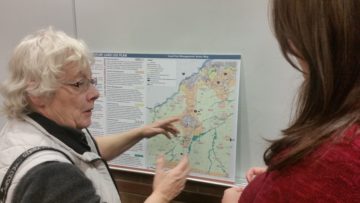By JAN LARSON McLAUGHLIN
BG Independent News
Wood County’s land use plans get more colorful as the county continues to try steering development toward the best areas for growth.
“It may not happen overnight, but it’s coming,” said Wood County Planning Director Dave Steiner. And the county wants to see that growth going to areas with the roads, waterlines and sewer lines to handle it – while maintaining the agricultural and natural areas that are also important to the county.
Last week, the county planning commission unveiled the draft of its latest land use plan. The plan takes into consideration the latest census information, demographics and development.
“I didn’t want to work off the old one at all,” Steiner said during an open house on the plan held at the county library.
The county had outgrown the last land use plan, which had been adopted in 2007.
“There were a lot of changes that hadn’t even taken place yet,” like the CSX intermodal hub near North Baltimore. “I wanted something more substantial.”
The plan also looks at “reinvestment areas,” where previous development has “fallen by the wayside” and may need a jumpstart with brownfield development, Steiner said.
And the plan defends agricultural areas that are still vital to the county’s economy. “We’ve designated a chunk where we don’t want anything,” he said. “We want to protect agriculture.”

The guiding principles of the land use plan are as follows:
- Support sustainable land use and development patterns, and identify and protect natural and environmental resources.
- Protect prime agricultural land and support agricultural production.
- Target economic development areas to support and attract employment generating uses.
- Identify sensitive natural areas for protection, possible areas for recreation in coordination with these natural areas, and historic or cultural sites to protect.
- Make efforts to promote redevelopment and reinvestment in areas with existing infrastructure and services and strategically manage the outward expansion of suburban development particularly in townships with the greatest growth pressures.
The land use plan, developed by McBride Dale Clarion from Cincinnati, will next go before the county planning commission for review, then finally to the county commissioners for approval.
The plan is available for public viewing at the county planning commission, at the county commissioners office, and online at http://planning.co.wood.oh.us.
Emily Crow, who helped develop the land use plan, said Wood County was different than other clients because of its size. “Unlike a lot of communities that have a lot of what Wood County has, Wood County is very big,” she said.
The land use plan can be used by other governmental entities in the county to help steer growth as well, Crow said. “There was a very conscious effort to create a tool that the townships can use and the smaller villages can use.”
Because the plan is more detailed than those in the past, it gives more guidance, yet “this adds a lot more flexibility,” Crow said. “The purpose of all this is to give a flexible tool that can work for all the townships.”
The ultimate goal is to help the county grow in healthy ways. “When it happens, we want that growth to be good for the community,” she said.
The plan identifies the following areas:
- Growth management areas, which have dense transportation networks, access to sewer and water services, and are areas already exhibiting growth pressures.
- Rural management areas, which are predominantly agricultural and low density rural residential.
- Enhancement areas, which have existing development that is currently stable but may experience change over the coming decades. Most of these areas are residential, but has some retail development.
- Reinvestment areas have existing development and infrastructure but may be showing signs of disinvestment, vacancy or potential for reinvestment.
- Targeted economic development areas, where the county and townships would like to focus economic development.
- Natural resources/water quality management areas, particularly in the Maumee and Portage River areas, which the county wishes to protect.

